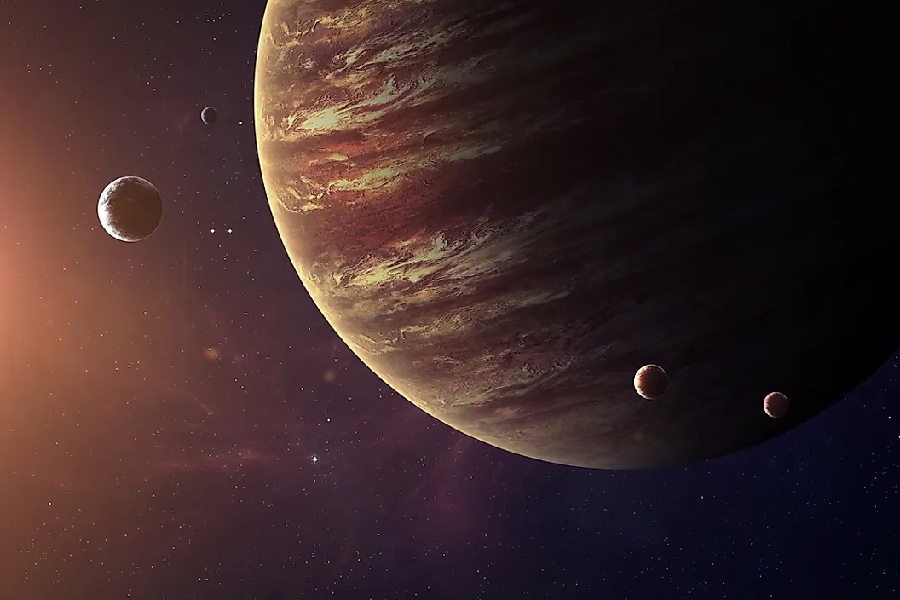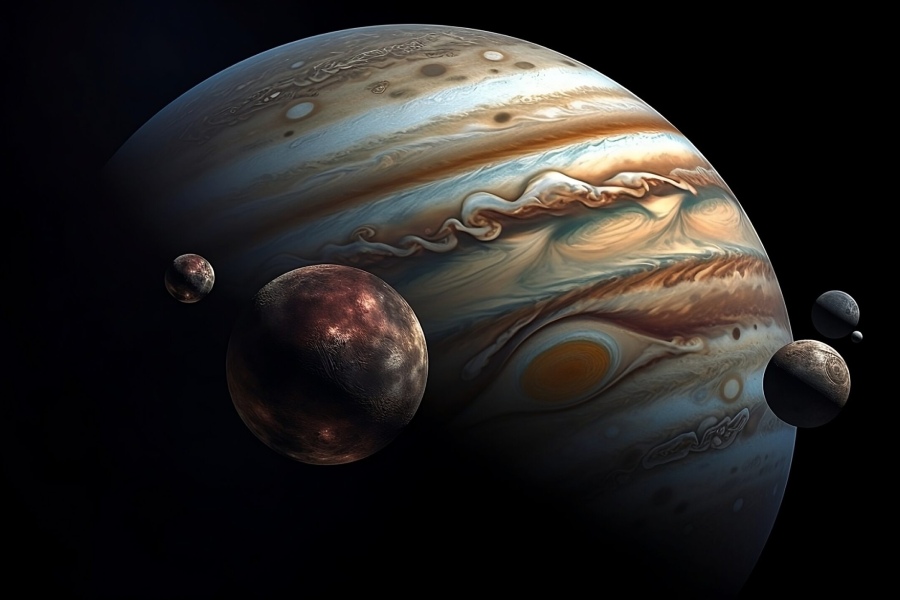Jupiter, the largest planet in our Solar System, has over 95 confirmed moons orbiting around it. From small asteroid-sized satellites to the giant Ganymede, these natural orbiting bodies present a fascinating celestial phenomenon.
How exactly do these myriad moons remain gravitationally bound to Jupiter rather than flying off into space or falling into the gas giant? What forces keep their complex orbital paths stable over astronomical spans of time?
Understanding the mechanisms that maintain satellites in orbit can provide insight into Jupiter’s past and how its system of moons formed.
This article will explore various theories that help explain how do Jupiter’s moons stay in orbit. We’ll explore tidal forces, resonances, orbital velocities, and other critical concepts to shed light on how diverse Jovian moons manage to stay in orbit.
While part of the answer lies in Jupiter’s huge mass, other subtle factors turn out to be equally important. Stay with us to decode the truth about this intriguing phenomenon.

How Do Jupiter’s Moons Stay in Orbit?
How do Jupiter’s moons stay in orbit? Jupiter’s moons stay in orbit due to a dance between gravity and motion. Picture throwing a ball: gravity pulls it down. Similarly, Jupiter’s gravity pulls its moons. But these moons are also zooming forward quickly.
This dual motion, a blend of gravity’s pull and sideways speed, prevents them from crashing into Jupiter. It’s like a perpetual falling act with enough sideways momentum to keep the moons circling the giant planet, creating a delicate orbital balance in the vastness of space.
Types of Jupiter’s Moons
Introduction to Jupiter’s moon diversity
There are over 95 moons that orbit Jupiter. These natural satellites come in a wide range of sizes, from tiny moonlets less than a mile across to enormous Ganymede, which is larger than the planet Mercury. Their composition and other characteristics also vary greatly.
Jupiter’s diverse moons can be divided into three primary groups based on orbit and origin.
The four innermost moons are known as the Galilean satellites. They have nearly circular orbits and formed along with Jupiter. Many smaller, irregular outer moons were likely captured asteroids or fragments. There are also a handful of mid-sized, distant, regular satellites.
Galilean vs other moons
The four Galilean moons – Io, Europa, Ganymede, and Callisto – are Jupiter’s largest and innermost satellites. Their orbits are nearly circular and close to Jupiter’s equatorial plane. The Galilean moons likely formed from the same spinning disk of gas and dust that created Jupiter.
They have bulk compositions similar to terrestrial planets, with elements like silicates and metals. Many of Jupiter’s outer, irregular moons have elongated, distant, highly eccentric orbits tilted at angles to Jupiter’s equator.
Rather than forming alongside Jupiter, these small moons were likely asteroids wandering too close and captured by Jupiter’s mighty gravity. Most orbit in retrograde motion opposite to Jupiter’s rotation. Their composition tends toward low density carbonaceous materials.
Varied orbits of inner and outer moons
The Galilean moons and other inner regular satellites have prograde orbits with low inclination and low eccentricity. Their nearly circular, equatorial paths keep them close to Jupiter, completing orbits in just days or weeks. These close orbits and gravitational tugs keep the inner moons’ orbits stable.
In contrast, captured outer moons have orbits that are elliptical, inclined, retrograde, and farther from Jupiter. Their orbital eccentricities vary greatly, carrying them as close as seven million miles or as far as over 20 million miles from Jupiter. These irregular orbits result in less stable paths, and Jupiter’s gravity can shred or eject the moons over astronomically short time periods.
Stable Orbits and Balancing Forces
Orbital stability and the equilibrium concept
For a moon to maintain a stable orbit, it must balance two opposing forces. The inward force of Jupiter’s gravity pulls moons in, and the outward centrifugal force pushes moons away. Equilibrium allows closed orbital paths. Disrupting the equilibrium can alter moon orbits over time or eject them.
The ratio of gravity-to-centrifugal forces differs based on a moon’s orbital distance and velocity. Regular inner moons stay in gravitational lockstep with Jupiter, but small shifts perturb eccentric outer moon orbits, eventually pulling them away.
Balancing centripetal force and gravitational force
The centripetal force pulls objects towards the center. Jupiter’s immense mass generates powerful centripetal force – its gravity tugging moons inward. Centrifugal force pushes outward as moons move perpendicular to the pull of gravity. In stable orbits, the two forces reach equilibrium.
Jupiter’s gravitational effects are strongest on inner, regular satellites like Io and Europa. At their close orbital distances, gravity overcomes centrifugal forces, keeping their nearly circular paths stable over billions of years despite perturbations.
Farther outer moons feel substantially weaker gravitational tugs from Jupiter, allowing centrifugal forces to slowly expand their eccentric orbits.
Moon velocity and distance in orbit
Inner moons like Ganymede orbit Jupiter rapidly at velocities exceeding 100,000 mph. Their orbital speeds help counteract Jupiter’s gravitational pull to stabilize close-in, circular orbits over astronomical timeframes.
In contrast, distant irregular moons creep along at just a few thousand mph – too slow for Jupiter’s gravity to dominate at such remote distances. Both distance and velocity affect orbit stability. Io orbits less than 300,000 miles from Jupiter’s cloud tops, while tiny Himalia is over seven million miles away.
Jupiter’s gravity is more than 20,000 times stronger on Io than Himalia. As distance increases, gravitational force drops substantially faster than velocity differences can compensate, gradually leading to destabilized irregular orbits.

Tidal Forces and Synchronization
Tidal forces between Jupiter and moons
In addition to gravity, Jupiter’s moons experience tidal forces between their solid bodies and Jupiter’s gaseous mass. These arise from variations in Jupiter’s gravitational pull across the moon’s diameter. This differential force distorts moons slightly along the axis facing Jupiter.
Tidal forces induce bulges on Jupiter-facing hemispheres as moons get stretched inward. Meanwhile, farside hemispheres get pulled backward, creating a second bulge. Io exhibits large asymmetrical bulges exceeding 300 feet due to its extreme tidal heating from Jupiter. Some moons orbit in harmonic periods that amplify tidal forces through resonance.
Tidal locking and period sync
Many large inner moons orbit synchronously with their rotation, keeping one hemisphere perpetually facing Jupiter. Their once-faster spins have slowed to match orbital periods of a few days under persistent tidal drag. Outer irregular moons spin chaotically without synchronization.
Jupiter’s strong tidal forces drive continuing flexing within Io that converts gravitational potential energy into intense internal heating that powers its extreme volcanism. More distant, tidally locked moons feel weaker forces, resulting in less internal heating through tidal kneading.
Affects on Jupiter’s moons
Several moons, including fiery Io and subtly active frozen Europa, exhibit enhanced surface and interior activity driven by Jupiter’s tidal forces. Ganymede may also experience periodic cryovolcanism due to subsurface tidal heating despite lacking surface eruptions.
Heavily cratered farside lunar hemispheres contrast with smoother nearsides resurfaced by tidal heating and volcanism. The stark differences in appearance arise from variations in internal activity between Jupiter-facing and farside hemispheres on tidally locked moons. Io’s tidal bulge shifts slightly ahead of the axis facing Jupiter.
Resonances and Orbital Dynamics
Definition of orbital resonances
Some moons have orbital periods related by ratios of small integers. When one moon completes a specific number of orbits, another finishes a different set. These harmonic relationships are called orbital resonances, they arise from gravitational effects between moons.
The most common resonances involve ratios like 2:1 or 3:2, if a moon orbits twice for each single orbit of another, their periods are in a 2:1 resonance. The inner Galilean moons have a 4:2:1 resonance – Io:Europa:Ganymede. Many resonances likely formed as moons migrated over time.
The time for resonating moons to return to the same relative positions is long – around two years for a 3:2 resonance. But alignments reinforce gravitational effects, seen as perturbations like tidal heating or orbital shifts. The cyclic nature helps maintain resonant relationships over astronomical spans.
Resonant relationships among Jupiter’s moons
The inner three Galileans have a 4:2:1 orbital resonance. Io orbits four times for every two Europa orbits and every single orbit by massive Ganymede. Their gravitational pushes and pulls on each other maintain the stable resonance they’ve held for billions of years since formation.
Groups of retrograde irregular moons further from Jupiter also exhibit stabilizing resonances. Himalia, Elara, Lysithea, Carme, and Ananke have periods linked by ratios like 3:1, 4:3, or 5:3. Their resonant orbits likely result from captures into harmonic paths.
Resonant orbits stability
When resonating moons periodically align, their additive gravitational tugs cause temporary perturbations. Small path deviations or energy exchanges build over successive resonant cycles. This tidal kneading drives internal heating within some moons like Io and Europa.
Mathematical models suggest resonances gravitationally shield moons from collisions. By periodically altering orbits, resonances make it harder for stray objects to strike at times of alignment. So resonant relationships may afford some safety advantages in Jupiter’s busy, moon-filled orbital space.
Modeling also indicates resonant configurations enable multiple moons to remain gravitationally interlinked in shared orbital systems over astronomical timeframes spanning billions of years. These stabilizing harmonic relationships will likely persist far into the future of Jupiter’s diverse moon system.
Perturbations and Orbital Changes
Influences from other moons and celestial bodies
In Jupiter’s crowded system, moons tug at each other. These gravitational forces cause oscillations that periodically alter orbits. The effects are more pronounced when resonant moons align but occur all across the system. Over time, the fluctuations perturb moon orbits.
Outside celestial bodies like the Sun also gravitationally influence Jupiter’s moons. Their small extra pulls add to fluctuations from other moons. These external perturbations combine with resonances to change orbits. Disrupted resonances or building perturbations can destabilize some moons.
Perturbations and moon orbit changes
Gravitational tugs and tidal forces stretch and relax moon orbits, changing eccentricities periodically. Voyager images revealed unpredicted perturbations in 1979 as multiple moons moved from expected positions. Combined fluctuations enable more oval-shaped rather than circular orbital paths.
Perturbations in orbit can also alter rotation rates. Io’s orbit has likely changed since Galileo first observed it, adding some faster wobble and geologic activity. The prior stable state may return in coming years as Io’s orbit settles back closer to the resonance with Europa that controls its spinning.
Moons’ long-term orbit evolution
There is evidence of long-term orbital changes as moons very gradually shift position over millions or billions of years. Subtle decay from perturbations results in extremely slow inward spiraling, known as orbital migration, moving many larger inner moons slightly closer over time.
The smaller outer prograde moons teeter on the edge of stability. Modeling suggests that over a few hundred million more years of slight perturbations, up to a third could eventually escape Jupiter’s grip or collide with each other or other moons due to progressively shifting irregular orbits.
Conclusion
We have realized how a principle of intricate balances and resonances holds the answer to the question of how do Jupiter’s moons stay in orbit. Achieving equilibrium is essential, balancing Jupiter’s gravity, which pulls inward strongly, and the outward centrifugal forces generated by the moons’ orbital motions.
This equilibrium is crucial for the four inner Galilean moons, as it keeps them engaged in a locked gravitational dance while orbiting Jupiter. Captured outer moons face an intricate combination of effects. These include the role of distance in weakening Jupiter’s gravity grip as well as tidal forces molding shape and activity, enabling their tenuous retrograde orbits to persist despite continual perturbations.
We hope you can now appreciate the advanced celestial mechanics that govern how Jupiter’s moons, from fiery Io to tiny irregulars manage to stay in their orbits, influencing stability, motion, and tidal heating to manifest unique properties.
